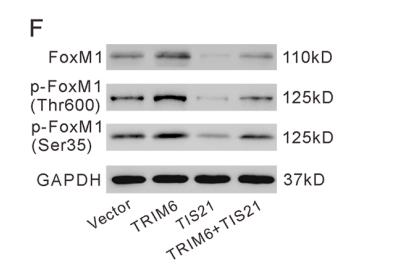Phospho-FOXM1 (Thr600) Antibody - #AF7360
| Product: | Phospho-FOXM1 (Thr600) Antibody |
| Catalog: | AF7360 |
| Description: | Rabbit polyclonal antibody to Phospho-FOXM1 (Thr600) |
| Application: | WB IHC IF/ICC |
| Cited expt.: | WB |
| Reactivity: | Human, Mouse, Rat |
| Prediction: | Pig, Zebrafish, Bovine, Horse, Sheep, Rabbit, Dog, Chicken, Xenopus |
| Mol.Wt.: | 84kD, 100-130kD; 84kD(Calculated). |
| Uniprot: | Q08050 |
| RRID: | AB_2843800 |
Related Downloads
Protocols
Product Info
*The optimal dilutions should be determined by the end user. For optimal experimental results, antibody reuse is not recommended.
*Tips:
WB: For western blot detection of denatured protein samples. IHC: For immunohistochemical detection of paraffin sections (IHC-p) or frozen sections (IHC-f) of tissue samples. IF/ICC: For immunofluorescence detection of cell samples. ELISA(peptide): For ELISA detection of antigenic peptide.
Cite Format: Affinity Biosciences Cat# AF7360, RRID:AB_2843800.
Fold/Unfold
FKHL16; Forkhead box M1; Forkhead box protein M1; forkhead like 16; Forkhead-related protein FKHL16; FOX M1; Foxm1; FOXM1_HUMAN; FOXM1B; Hepatocyte nuclear factor 3 forkhead homolog 11; HFH-11; HFH11; HNF-3/fork-head homolog 11; HNF3; INS1; M phase phosphoprotein 2; M-phase phosphoprotein 2; MPHOSPH2; MPM-2 reactive phosphoprotein 2; MPP2; PIG29; TGT3; Transcription factor Trident; Trident; WIN; Winged-helix factor from INS-1 cells; Winged-helix factor from INS1 cells;
Immunogens
A synthesized peptide derived from human FOXM1 around the phosphorylation site of Thr600.
Expressed in thymus, testis, small intestine, colon followed by ovary. Appears to be expressed only in adult organs containing proliferating/cycling cells or in response to growth factors. Also expressed in epithelial cell lines derived from tumors. Not expressed in resting cells. Isoform 2 is highly expressed in testis.
- Q08050 FOXM1_HUMAN:
- Protein BLAST With
- NCBI/
- ExPASy/
- Uniprot
MKTSPRRPLILKRRRLPLPVQNAPSETSEEEPKRSPAQQESNQAEASKEVAESNSCKFPAGIKIINHPTMPNTQVVAIPNNANIHSIITALTAKGKESGSSGPNKFILISCGGAPTQPPGLRPQTQTSYDAKRTEVTLETLGPKPAARDVNLPRPPGALCEQKRETCADGEAAGCTINNSLSNIQWLRKMSSDGLGSRSIKQEMEEKENCHLEQRQVKVEEPSRPSASWQNSVSERPPYSYMAMIQFAINSTERKRMTLKDIYTWIEDHFPYFKHIAKPGWKNSIRHNLSLHDMFVRETSANGKVSFWTIHPSANRYLTLDQVFKPLDPGSPQLPEHLESQQKRPNPELRRNMTIKTELPLGARRKMKPLLPRVSSYLVPIQFPVNQSLVLQPSVKVPLPLAASLMSSELARHSKRVRIAPKVLLAEEGIAPLSSAGPGKEEKLLFGEGFSPLLPVQTIKEEEIQPGEEMPHLARPIKVESPPLEEWPSPAPSFKEESSHSWEDSSQSPTPRPKKSYSGLRSPTRCVSEMLVIQHRERRERSRSRRKQHLLPPCVDEPELLFSEGPSTSRWAAELPFPADSSDPASQLSYSQEVGGPFKTPIKETLPISSTPSKSVLPRTPESWRLTPPAKVGGLDFSPVQTSQGASDPLPDPLGLMDLSTTPLQSAPPLESPQRLLSSEPLDLISVPFGNSSPSDIDVPKPGSPEPQVSGLAANRSLTEGLVLDTMNDSLSKILLDISFPGLDEDPLGPDNINWSQFIPELQ
Predictions
Score>80(red) has high confidence and is suggested to be used for WB detection. *The prediction model is mainly based on the alignment of immunogen sequences, the results are for reference only, not as the basis of quality assurance.
High(score>80) Medium(80>score>50) Low(score<50) No confidence
Research Backgrounds
Transcriptional factor regulating the expression of cell cycle genes essential for DNA replication and mitosis. Plays a role in the control of cell proliferation. Plays also a role in DNA breaks repair participating in the DNA damage checkpoint response.
Phosphorylated in M (mitotic) phase. Phosphorylation by the checkpoint kinase CHEK2 in response to DNA damage increases the FOXM1 protein stability probably stimulating the transcription of genes involved in DNA repair. Phosphorylated by CDK1 in late S and G2 phases, creating docking sites for the POLO box domains of PLK1. Subsequently, PLK1 binds and phosphorylates FOXM1, leading to activation of transcriptional activity and subsequent enhanced expression of key mitotic regulators.
Nucleus.
Expressed in thymus, testis, small intestine, colon followed by ovary. Appears to be expressed only in adult organs containing proliferating/cycling cells or in response to growth factors. Also expressed in epithelial cell lines derived from tumors. Not expressed in resting cells. Isoform 2 is highly expressed in testis.
Within the protein there is a domain which acts as a transcriptional activator. Insertion of a splicing sequence within it inactivates this transcriptional activity, as it is the case for isoform 4.
Research Fields
· Cellular Processes > Cell growth and death > Cellular senescence. (View pathway)
References
Application: WB Species: Human Sample: Sw620 cells
Restrictive clause
Affinity Biosciences tests all products strictly. Citations are provided as a resource for additional applications that have not been validated by Affinity Biosciences. Please choose the appropriate format for each application and consult Materials and Methods sections for additional details about the use of any product in these publications.
For Research Use Only.
Not for use in diagnostic or therapeutic procedures. Not for resale. Not for distribution without written consent. Affinity Biosciences will not be held responsible for patent infringement or other violations that may occur with the use of our products. Affinity Biosciences, Affinity Biosciences Logo and all other trademarks are the property of Affinity Biosciences LTD.




